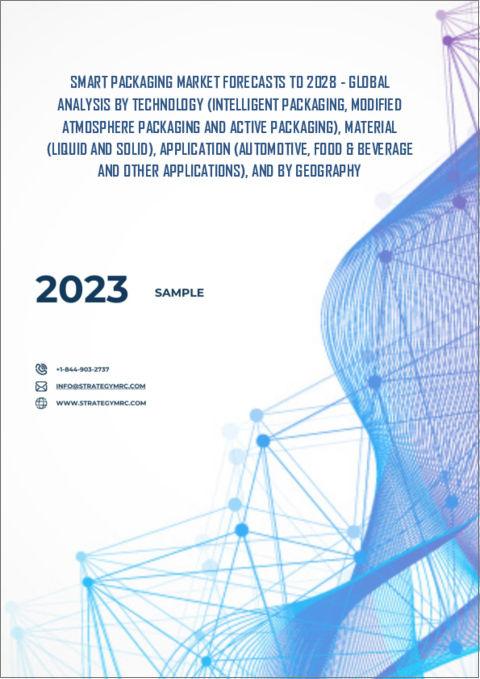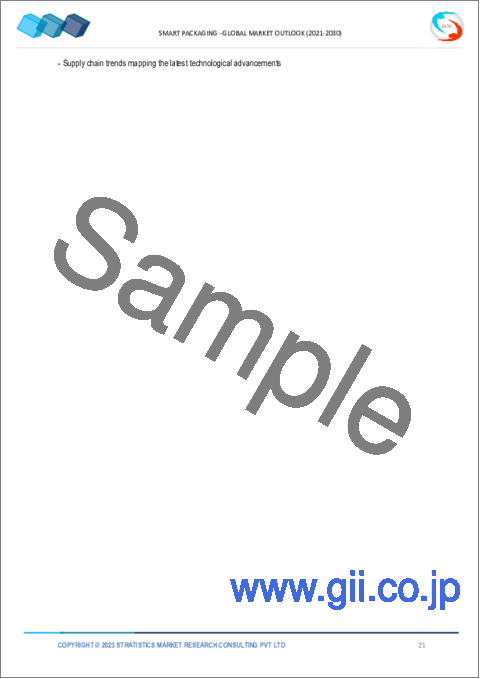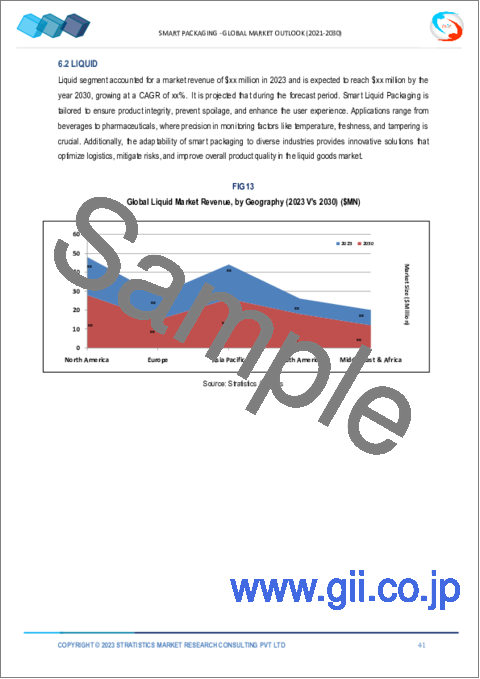|
|
市場調査レポート
商品コード
1273274
スマートパッケージングの2028年までの市場予測- 技術、材料、用途、地域別の世界分析Smart Packaging Market Forecasts to 2028 - Global Analysis By Technology, Material, Application, and By Geography |
||||||
|
● お客様のご希望に応じて、既存データの加工や未掲載情報(例:国別セグメント)の追加などの対応が可能です。 詳細はお問い合わせください。 |
|||||||
| スマートパッケージングの2028年までの市場予測- 技術、材料、用途、地域別の世界分析 |
|
出版日: 2023年05月01日
発行: Stratistics Market Research Consulting
ページ情報: 英文 175+ Pages
納期: 2~3営業日
|
- 全表示
- 概要
- 図表
- 目次
Stratistics MRCによると、スマートパッケージングの世界市場は、2022年に257億2,143万米ドルを占め、予測期間中に7.5%のCAGRで成長し、2028年には 396億9,593万米ドルに達すると予想されています。
スマートパッケージングは、エンジンの効果やパワーを高めるデバイスの一種です。スマートパッケージング」という用語は、食品や医薬品を含むさまざまな商品に使用される、センサーを搭載した特定の種類のパッケージングシステムを指します。スマートパッケージング技術は、製品の品質、賞味期限、鮮度監視、顧客と製品の安全性の向上に貢献するものです。これらのインテリジェントシステムは、インテリジェント技術で包装された製品の品質や鮮度に関する情報を提供します。
フレキシブル・パッケージング協会によると、フレキシブル・パッケージングは主に食品に使用されており、市場全体の60%以上を占めています。国連環境計画によると、世界で生産される全食品のうち、毎年約13億メートルトン(14億3,000万トン)が失われたり、無駄になったりします。米国では、年間1,330億ポンド(約1,610億米ドル)の食品が廃棄されていると推定されます。
市場力学:
促進要因
食品業界におけるスマートパッケージングの需要拡大
スマートパッケージングは、飲食品産業において、輸送中の製品の位置を追跡し、品質や鮮度を監視し、消費者に内容物や栄養価に関する情報を提供するために使用することができます。これにより、商品の品質や安全性だけでなく、買い物体験も向上する可能性があります。食品の鮮度や、ほこり、汚れ、におい、水蒸気、熱、酸素、細菌などの汚染物質に対する防御に対する人々の関心が高まるにつれ、これらの要素はますます考慮されるようになってきています。また、温度を調節し、食品の安全性と鮮度を保つスマートパッケージングに対する消費者の需要によって、スマートパッケージングの市場は拡大しつつあります。
抑制要因
大量生産用途でのコスト高
包装アプリケーションに使用されるセンサーやRFID(Radio Frequency Identification)のコストが高いため、より良い包装は従来の包装よりも高価であり、これが包装システムの大量アプリケーションの失敗の一因となっています。包装用途に利用されるセンサーや無線自動識別(RFID)が高価なため、より良い包装は従来の包装形態よりも高価であり、包装システムのための大規模なアプリケーションで失敗しています。
機会:
eコマースがパッケージング部門にチャンスをもたらす
顧客に安心と安全を提供するために、eコマース業界の成長とともに、より多くの技術的進歩がなされています。オンラインショッピングは、先進国、途上国、発展途上国において、より一般的になってきています。また、出荷監視や製品配送に関する情報を顧客に提供するインテリジェントパッケージングソリューションは、魅力的な市場の可能性を生み出しています。さらに、eコマース産業の拡大、産業化の加速、優れたサプライチェーン管理へのニーズの高まりは、市場参入企業に魅力的な可能性をもたらすと予測されています。
脅威
高価な技術の導入
スマートパッケージング分野の企業が直面する最大の困難は、顧客価格を引き上げたり下げたりすることなく、高価な新技術をパッケージに搭載する方法を見つけ出すことです。この種のパッケージの利点について消費者を教育し、パッケージの規則に準拠した最先端センサーの独自の生産プロセスを構築することも、さらなる障害となります。
COVID-19の影響:
COVID-19の発生により、建設業、製造業、接客業、観光業はいずれも大きな影響を受けた。製造業の操業は停止または制限されました。世界的には、建設業や輸送業の供給網が寸断されました。このため、スマートパッケージングの生産量だけでなく、市場の需要も減少し、スマートパッケージングの市場拡大が妨げられました。一方、企業は徐々に通常の商品・サービスの提供を開始しました。その結果、スマートパッケージング企業はフル稼働で業務を再開することができ、2021年末には市場の回復を支援しました。
予測期間中、固形物セグメントが最大となる見込み
固形物セグメントは有利な成長を遂げると推定されます。センサーやスマートラベルなどの固体技術を利用して、消費者体験を向上させ、追加の製品情報、鮮度、安全性、保存に関する推奨事項を提供する包装は、固体スマート包装と呼ばれます。これらの技術は、消費者に最新の製品情報を提供するインタラクティブなパッケージングを実現するために使用することができます。ソリッド・スマート・パッケージングには通常、温度感受性ラベル、湿度感受性ラベル、RFID対応パッケージング、インタラクティブ・パッケージングなどのアプリケーションがあります。
予測期間中、飲食品分野のCAGRが最も高くなると予想される
飲食品分野は、予測期間中に最も高いCAGR成長を遂げると予測されています。これにはいくつかの理由があります。いつでも手に入り、利用しやすく、賞味期限が長い食品を購入することが好まれるのです。ここでも、インテリジェント・パッキングがこれらを保証することができます。また、最新の厳しい食品安全法の遵守が容易になるため、飲食品のサブセグメントに属する企業の大半が、スマートパッケージングを使用する意欲を持っています。
最もシェアの高い地域
北米は、予測期間中、最も高い市場シェアを維持すると予測されています。これは、人口増加の結果、食品や液体に対する要求が明らかに増加したためです。食品業界の膨大な需要に対応するため、世界のさまざまな地域から輸入される食品の量は大幅に増加しており、この地域でスマートパッケージングソリューションの需要を後押ししています。食品の保存期間の延長と投資の拡大が、北米地域におけるスマートパッケージングの需要を高めています。
CAGRが最も高い地域:
アジア太平洋地域は、多くの最終用途産業における高度なパッケージング技術の採用の増加、同地域における食品・飲食品の需要の増加、eコマースの拡大により、予測期間中最も高いCAGRを示すと予測されます。また、アジア太平洋地域には、中国、インド、日本、韓国などの経済大国があり、同地域のスマートパッケージング市場の拡大を促進すると予想されています。
主な発展:
2019年4月、Tetra Pakは、牛乳やジュースのカートンをテクノロジーツール、大型データキャリア、インタラクティブな情報コンジットに変える、リンク型パッケージングプラットフォームを発表しました。小売業者がサプライチェーンにもっとアクセスできるようになれば、流通業者は在庫の動きを追跡し、リアルタイムの情報を得ることができるようになります。
2019年2月、シールドエアーはMGMのフレキシブルパッケージング部門を買収しました。フレキシブルな食品包装材料は、有名な包装会社であるMGMが消費者向けパッケージ商品の東南アジア市場向けに提供しています。買収の2大目的は、アジア太平洋における地位の強化と、印刷とラミネートの能力の高度化です。
当レポートが提供するもの
- 地域レベル、国レベルのセグメントにおける市場シェア評価
- 新規参入企業への戦略的提言
- 2020年、2021年、2022年、2025年、2028年の市場データを網羅
- 市場促進要因(市場動向、制約要因、機会、脅威、課題、投資機会、推奨事項)。
- 市場推定に基づく、主要ビジネスセグメントにおける戦略的提言
- 主要な共通トレンドをマッピングした競合情勢。
- 詳細な戦略、財務、最近の開発状況を含む企業プロファイル
- 最新の技術的進歩をマッピングしたサプライチェーン動向
無料のカスタマイズ提供:
本レポートをご購入いただいたお客様には、以下の無料カスタマイズオプションのいずれかを提供させていただきます:
- 企業プロファイル
- 追加市場プレイヤーの包括的なプロファイリング(最大3社まで)
- 主要プレイヤーのSWOT分析(3社まで)
- 地域別セグメンテーション
- お客様のご希望に応じて、主要国の市場推計・予測・CAGR(注:フィージビリティチェックによる。)
- 競合ベンチマーキング
- 製品ポートフォリオ、地域的プレゼンス、戦略的提携に基づく主要プレイヤーのベンチマーキング
目次
第1章 エグゼクティブサマリー
第2章 序文
- 概要
- ステークホルダー
- 調査範囲
- 調査手法
- データマイニング
- データ分析
- データ検証
- 調査アプローチ
- 調査ソース
- 1次調査ソース
- 2次調査ソース
- 仮定
第3章 市場動向分析
- 促進要因
- 抑制要因
- 機会
- 脅威
- 技術分析
- アプリケーション分析
- 新興市場
- 新型コロナウイルス感染症(COVID-19)の影響
第4章 ポーターのファイブフォース分析
- 供給企業の交渉力
- 買い手の交渉力
- 代替品の脅威
- 新規参入業者の脅威
- 競争企業間の敵対関係
第5章 世界のスマートパッケージング市場:技術別
- インテリジェントなパッケージング
- センサー
- バイオセンサー
- ガスセンサー
- 指標
- データキャリア
- バーコード
- 2次元マトリックスコード
- クイックレスポンスコード
- 拡張マトリックスコード
- RFIDタグ
- センサー
- ガス置換包装
- アクティブパッケージング
- 抗菌フィルム
- 酸化防止剤
- 二酸化炭素スカベンジャー/エミッター
- エチレンスカベンジャー&エミッター
- エタノールエミッター
- 風味・臭気吸収剤
- 湿気除去剤
- 脱酸素剤
- マイクロ波サセプター
- 自己通気フィルム
- 温度管理包装
第6章 世界のスマートパッケージング市場:材料別
- 液体
- 固体
第7章 世界のスマートパッケージング市場:用途別
- 自動車
- 飲食品
- ヘルスケア
- パーソナルケア
- その他の用途
第8章 世界のスマートパッケージング市場:地域別
- 北米
- 米国
- カナダ
- メキシコ
- 欧州
- ドイツ
- 英国
- イタリア
- フランス
- スペイン
- その他欧州
- アジア太平洋地域
- 日本
- 中国
- インド
- オーストラリア
- ニュージーランド
- 韓国
- その他アジア太平洋地域
- 南米
- アルゼンチン
- ブラジル
- チリ
- その他南米
- 中東とアフリカ
- サウジアラビア
- アラブ首長国連邦
- カタール
- 南アフリカ
- その他中東とアフリカ
第9章 主な発展
- 契約、パートナーシップ、コラボレーション、合弁事業
- 買収と合併
- 新製品の発売
- 事業拡大
- その他の主要戦略
第10章 会社概要
- Sysco Corporation
- Zebra Technologies Corp.
- Ball Corporation
- BASF SE,
- Crown
- R.R. Donnelley & Sons Company
- Avery Dennison Corporation
- 3M
- International Paper
- Stora Enso
- Sealed Air Corporation
- Amcor Plc
- Huhtamaki PPL Ltd
- Thin Film Electronics ASA
- Smartrac N.V.
- Emerson Electric Co.
List of Tables
- Table 1 Global Smart Packaging Market Outlook, By Region (2020-2028) ($MN)
- Table 2 Global Smart Packaging Market Outlook, By Technology (2020-2028) ($MN)
- Table 3 Global Smart Packaging Market Outlook, By Intelligent Packaging (2020-2028) ($MN)
- Table 4 Global Smart Packaging Market Outlook, By Sensors (2020-2028) ($MN)
- Table 5 Global Smart Packaging Market Outlook, By Bio Sensors (2020-2028) ($MN)
- Table 6 Global Smart Packaging Market Outlook, By Gas Sensors (2020-2028) ($MN)
- Table 7 Global Smart Packaging Market Outlook, By Indicators (2020-2028) ($MN)
- Table 8 Global Smart Packaging Market Outlook, By Data Carriers (2020-2028) ($MN)
- Table 9 Global Smart Packaging Market Outlook, By Barcodes (2020-2028) ($MN)
- Table 10 Global Smart Packaging Market Outlook, By 2D Matrix Codes (2020-2028) ($MN)
- Table 11 Global Smart Packaging Market Outlook, By Quick Response Codes (2020-2028) ($MN)
- Table 12 Global Smart Packaging Market Outlook, By Augmented Matrix Codes (2020-2028) ($MN)
- Table 13 Global Smart Packaging Market Outlook, By RFID Tags (2020-2028) ($MN)
- Table 14 Global Smart Packaging Market Outlook, By Modified Atmosphere Packaging (2020-2028) ($MN)
- Table 15 Global Smart Packaging Market Outlook, By Active Packaging (2020-2028) ($MN)
- Table 16 Global Smart Packaging Market Outlook, By Antibacterial Films (2020-2028) ($MN)
- Table 17 Global Smart Packaging Market Outlook, By Antioxidants (2020-2028) ($MN)
- Table 18 Global Smart Packaging Market Outlook, By Carbon Dioxide Scavengers/Emitters (2020-2028) ($MN)
- Table 19 Global Smart Packaging Market Outlook, By Ethylene Scavengers &Emitters (2020-2028) ($MN)
- Table 20 Global Smart Packaging Market Outlook, By Ethanol Emitters (2020-2028) ($MN)
- Table 21 Global Smart Packaging Market Outlook, By Flavour/Odour Absorbers (2020-2028) ($MN)
- Table 22 Global Smart Packaging Market Outlook, By Moisture Scavengers (2020-2028) ($MN)
- Table 23 Global Smart Packaging Market Outlook, By Oxygen Scavengers (2020-2028) ($MN)
- Table 24 Global Smart Packaging Market Outlook, By Microwave Susceptors (2020-2028) ($MN)
- Table 25 Global Smart Packaging Market Outlook, By Self-Venting Films (2020-2028) ($MN)
- Table 26 Global Smart Packaging Market Outlook, By Temperature Control Packaging (2020-2028) ($MN)
- Table 27 Global Smart Packaging Market Outlook, By Material (2020-2028) ($MN)
- Table 28 Global Smart Packaging Market Outlook, By Liquid (2020-2028) ($MN)
- Table 29 Global Smart Packaging Market Outlook, By Solid (2020-2028) ($MN)
- Table 30 Global Smart Packaging Market Outlook, By Application (2020-2028) ($MN)
- Table 31 Global Smart Packaging Market Outlook, By Automotive (2020-2028) ($MN)
- Table 32 Global Smart Packaging Market Outlook, By Food & beverage (2020-2028) ($MN)
- Table 33 Global Smart Packaging Market Outlook, By Healthcare (2020-2028) ($MN)
- Table 34 Global Smart Packaging Market Outlook, By Personal care (2020-2028) ($MN)
- Table 35 Global Smart Packaging Market Outlook, By Other Applications (2020-2028) ($MN)
Note: Tables for North America, Europe, APAC, South America, and Middle East & Africa Regions are also represented in the same manner as above.
According to Stratistics MRC, the Global Smart Packaging Market is accounted for $25721.43 million in 2022 and is expected to reach $39695.93 million by 2028 growing at a CAGR of 7.5% during the forecast period. Smart packaging is a kind of device that boosts the engine's effectiveness and power. The term "smart packaging" refers to a particular kind of sensor-equipped packaging system used for a variety of goods, including food and pharmaceuticals. The smart packaging technology contributes to improving product quality, shelf life, freshness monitoring, and customer and product safety. These intelligent systems offer information on the product's quality and freshness when it is packaged with intelligent technology.
According to the Flexible Packaging Association, flexible packaging is mainly used for food, which accounts for more than 60% of the total market. According to the UN environment program, approximately 1.3 billion metric tons (1.43 billion tons) of all food produced globally is lost or wasted every year. In the United States, an estimated 133 billion pounds of food are wasted yearly, valued at USD 161 billion
Market Dynamics:
Driver:
Increasing demand for smart packaging in the food industry
Smart packaging can be used in the food and beverage industry to track a product's position during transportation, monitor its quality and freshness, and provide the consumer with information about its contents and nutritional value. This could improve the quality and safety of the goods as well as the shopping experience. As people become more concerned with food freshness and defence against contaminants including dust, grime, odour, water vapours, heat, oxygen, and germs, these elements are being taken into account more and more. The market for smart packaging is also being expanded by consumer demand for smart packaging that regulates temperature and keeps food safe and fresh.
Restraint:
High costs in mass applications
Due to the higher cost of sensors and radio frequency identification (RFIDs) used for packaging applications, better packaging is more expensive than conventional packaging, which contributes to the failure of mass applications for packaging systems. Better packaging is more expensive than traditional forms of packaging because the sensors and radio frequency identification (RFID) utilised for packaging applications are more expensive and are failing in large applications for packaging systems.
Opportunity:
E-commerce creates an opportunity for the packaging section
In order to provide clients with security and safety, more technological advancements are being made as the e-commerce industry grows. Online shopping is becoming more popular in developed, developing, and developing nations. Additionally, intelligent packaging solutions that provide clients with information about shipment monitoring and product delivery create attractive market potential. Furthermore, it is projected that the expanding E-commerce industry, accelerated industrialisation, and rising need for superior supply chain management would present market participants with appealing possibilities.
Threat:
Incorporating expensive technologies
The largest difficulty facing firms in the field of smart packaging is figuring out how to put pricey new technology into the packaging without raising or cutting customer prices. Educating consumers about the advantages of this kind of packaging and creating unique production processes for cutting-edge sensors that can adhere to packaging rules are additional obstacles.
COVID-19 Impact:
Construction, manufacturing, hospitality, and the tourism industries were all significantly impacted by the COVID-19 outbreak. Manufacturing operations were suspended or limited. Globally, supply networks for the construction and transportation industries were disrupted. This reduced the production of smart packaging as well as the market's demand for them, which hindered the market's expansion for smart packaging. On the other hand, businesses gradually began providing their usual goods and services. The smart packaging companies were able to resume operations at full capacity as a result, which assisted in the market's recovery by the end of 2021.
The solid segment is expected to be the largest during the forecast period
The solid segment is estimated to have a lucrative growth. Packaging that makes use of solid-state technologies, such as sensors and smart labels, to enhance the consumer experience and provide additional product information, as well as freshness, safety, and storage recommendations, is referred to as solid smart packaging. These technologies can be used to create interactive packaging that provides consumers with up-to-date product information. Solid smart packaging typically has applications like temperature-sensitive labels, humidity-sensitive labels, RFID-enabled packaging, and interactive packaging.
The food and beverage segment is expected to have the highest CAGR during the forecast period
The food and beverage segment is anticipated to witness the highest CAGR growth during the forecast period. There are a few reasons for this. They favour buying food that is always available, accessible, and has a long shelf life. Again, intelligent packing can guarantee these. Since it makes it easier for them to comply with the most recent and stringent food safety laws, the majority of enterprises in the food and beverage sub-segment are motivated to use smart packaging.
Region with highest share:
North America is projected to hold the highest market share during the forecast period owing to the requirement for food and liquids has clearly increased as a result of the growing population. To meet the enormous demands of the food industry, the amount of food imported from different areas of the world has substantially expanded, which has boosted the demand for smart packaging solutions in the area. The lengthening of food shelf life and growing investment are driving up the demand for smart packaging in the North American region.
Region with highest CAGR:
Asia Pacific is projected to have the highest CAGR over the forecast period, owing to the rising adoption of advanced packaging technologies in numerous end-use industries, the rising demand for food and beverage items in the area, and the expansion of e-commerce. In addition, the Asia-Pacific region is home to a number of significant economies, including China, India, Japan, and South Korea, which are anticipated to propel the expansion of the area's smart packaging market.
Key players in the market:
Some of the key players profiled in the Smart Packaging Market include: Sysco Corporation, Zebra Technologies Corp., Ball Corporation, BASF SE, Crown, R.R. Donnelley & Sons Company, Avery Dennison Corporation, 3M, International Paper, Stora Enso, Sealed Air Corporation, Amcor Plc, Huhtamaki PPL Ltd, Thin Film Electronics ASA, Smartrac N.V. and Emerson Electric Co.
Key Developments:
In April 2019, Tetra Pak unveiled a linked packaging platform that would transform milk and juice cartons into technology tools, large data carriers, and interactive information conduits. Distributors will be able to track stock movements and obtain real-time information if retailers have more access to the supply chain.
In February 2019, Sealed Air acquired the flexible packaging section of MGM. Flexible food packaging materials are provided by the well-known packaging company MGM for Southeast Asian markets for consumer packaged goods. The two major objectives of the purchase are to strengthen its position in Asia-Pacific and to advance its printing and laminating capabilities.
Technologies Covered:
- Intelligent Packaging
- Modified Atmosphere Packaging
- Active Packaging
Materials Covered:
- Liquid
- Solid
Applications Covered:
- Automotive
- Food & beverage
- Healthcare
- Personal care
- Other Applications
Regions Covered:
- North America
- US
- Canada
- Mexico
- Europe
- Germany
- UK
- Italy
- France
- Spain
- Rest of Europe
- Asia Pacific
- Japan
- China
- India
- Australia
- New Zealand
- South Korea
- Rest of Asia Pacific
- South America
- Argentina
- Brazil
- Chile
- Rest of South America
- Middle East & Africa
- Saudi Arabia
- UAE
- Qatar
- South Africa
- Rest of Middle East & Africa
What our report offers:
- Market share assessments for the regional and country-level segments
- Strategic recommendations for the new entrants
- Covers Market data for the years 2020, 2021, 2022, 2025, and 2028
- Market Trends (Drivers, Constraints, Opportunities, Threats, Challenges, Investment Opportunities, and recommendations)
- Strategic recommendations in key business segments based on the market estimations
- Competitive landscaping mapping the key common trends
- Company profiling with detailed strategies, financials, and recent developments
- Supply chain trends mapping the latest technological advancements
Free Customization Offerings:
All the customers of this report will be entitled to receive one of the following free customization options:
- Company Profiling
- Comprehensive profiling of additional market players (up to 3)
- SWOT Analysis of key players (up to 3)
- Regional Segmentation
- Market estimations, Forecasts and CAGR of any prominent country as per the client's interest (Note: Depends on feasibility check)
- Competitive Benchmarking
- Benchmarking of key players based on product portfolio, geographical presence, and strategic alliances
Table of Contents
1 Executive Summary
2 Preface
- 2.1 Abstract
- 2.2 Stake Holders
- 2.3 Research Scope
- 2.4 Research Methodology
- 2.4.1 Data Mining
- 2.4.2 Data Analysis
- 2.4.3 Data Validation
- 2.4.4 Research Approach
- 2.5 Research Sources
- 2.5.1 Primary Research Sources
- 2.5.2 Secondary Research Sources
- 2.5.3 Assumptions
3 Market Trend Analysis
- 3.1 Introduction
- 3.2 Drivers
- 3.3 Restraints
- 3.4 Opportunities
- 3.5 Threats
- 3.6 Technology Analysis
- 3.7 Application Analysis
- 3.8 Emerging Markets
- 3.9 Impact of Covid-19
4 Porters Five Force Analysis
- 4.1 Bargaining power of suppliers
- 4.2 Bargaining power of buyers
- 4.3 Threat of substitutes
- 4.4 Threat of new entrants
- 4.5 Competitive rivalry
5 Global Smart Packaging Market, By Technology
- 5.1 Introduction
- 5.2 Intelligent Packaging
- 5.2.1 Sensors
- 5.2.1.1 Bio Sensors
- 5.2.1.2 Gas Sensors
- 5.2.2 Indicators
- 5.2.3 Data Carriers
- 5.2.3.1 Barcodes
- 5.2.3.1.1 2D Matrix Codes
- 5.2.3.1.2 Quick Response Codes
- 5.2.3.1.3 Augmented Matrix Codes
- 5.2.3.2 RFID Tags
- 5.2.1 Sensors
- 5.3 Modified Atmosphere Packaging
- 5.4 Active Packaging
- 5.4.1 Antibacterial Films
- 5.4.2 Antioxidants
- 5.4.3 Carbon Dioxide Scavengers/Emitters
- 5.4.4 Ethylene Scavengers &Emitters
- 5.4.5 Ethanol Emitters
- 5.4.6 Flavour/Odour Absorbers
- 5.4.7 Moisture Scavengers
- 5.4.8 Oxygen Scavengers
- 5.4.9 Microwave Susceptors
- 5.4.10 Self-Venting Films
- 5.4.11 Temperature Control Packaging
6 Global Smart Packaging Market, By Material
- 6.1 Introduction
- 6.2 Liquid
- 6.3 Solid
7 Global Smart Packaging Market, By Application
- 7.1 Introduction
- 7.2 Automotive
- 7.3 Food & beverage
- 7.4 Healthcare
- 7.5 Personal care
- 7.6 Other Applications
8 Global Smart Packaging Market, By Geography
- 8.1 Introduction
- 8.2 North America
- 8.2.1 US
- 8.2.2 Canada
- 8.2.3 Mexico
- 8.3 Europe
- 8.3.1 Germany
- 8.3.2 UK
- 8.3.3 Italy
- 8.3.4 France
- 8.3.5 Spain
- 8.3.6 Rest of Europe
- 8.4 Asia Pacific
- 8.4.1 Japan
- 8.4.2 China
- 8.4.3 India
- 8.4.4 Australia
- 8.4.5 New Zealand
- 8.4.6 South Korea
- 8.4.7 Rest of Asia Pacific
- 8.5 South America
- 8.5.1 Argentina
- 8.5.2 Brazil
- 8.5.3 Chile
- 8.5.4 Rest of South America
- 8.6 Middle East & Africa
- 8.6.1 Saudi Arabia
- 8.6.2 UAE
- 8.6.3 Qatar
- 8.6.4 South Africa
- 8.6.5 Rest of Middle East & Africa
9 Key Developments
- 9.1 Agreements, Partnerships, Collaborations and Joint Ventures
- 9.2 Acquisitions & Mergers
- 9.3 New Product Launch
- 9.4 Expansions
- 9.5 Other Key Strategies
10 Company Profiling
- 10.1 Sysco Corporation
- 10.2 Zebra Technologies Corp.
- 10.3 Ball Corporation
- 10.4 BASF SE,
- 10.5 Crown
- 10.6 R.R. Donnelley & Sons Company
- 10.7 Avery Dennison Corporation
- 10.8 3M
- 10.9 International Paper
- 10.10 Stora Enso
- 10.11 Sealed Air Corporation
- 10.12 Amcor Plc
- 10.13 Huhtamaki PPL Ltd
- 10.14 Thin Film Electronics ASA
- 10.15 Smartrac N.V.
- 10.16 Emerson Electric Co.




